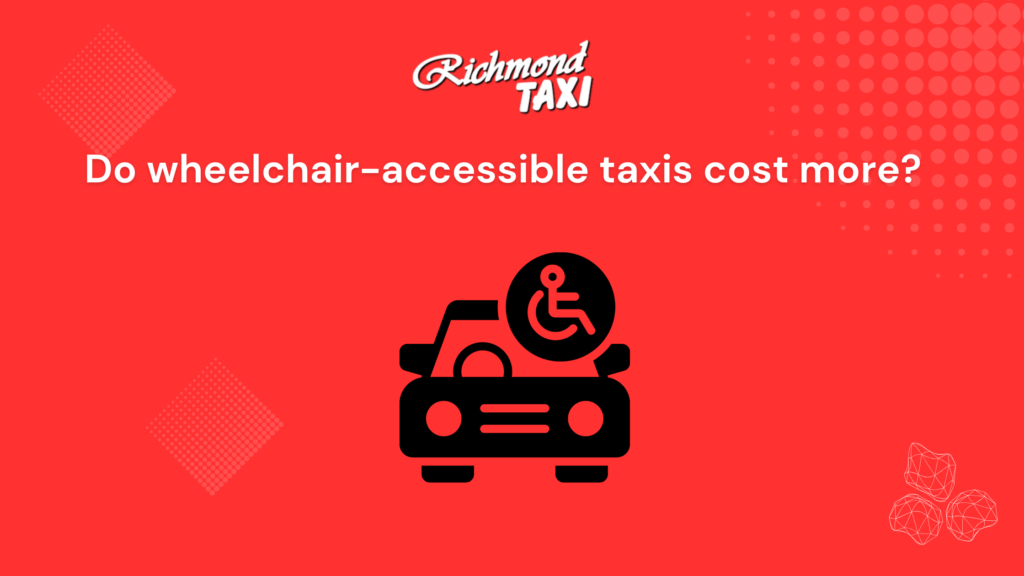Do wheelchair-accessible taxis cost more?

Transportation plays a crucial role in everyday life, especially for people with mobility challenges. Thankfully, wheelchair taxis make it possible for everyone to travel comfortably and safely. But one common question people often ask is — Do wheelchair-accessible taxis cost more than regular taxis? In this article, we’ll break down the factors that influence the cost of wheelchair accessible taxi cabs, explain why prices may differ slightly, and help you understand how to get the best value when booking a ride. What Are Wheelchair-Accessible Taxis? A wheelchair-accessible taxi (also known as a wheelchair taxi) is a specially modified vehicle designed to accommodate passengers who use wheelchairs or have limited mobility. These vehicles often include: Ramps or hydraulic lifts for easy entry and exit. Spacious interiors to fit both the passenger and the wheelchair. Safety restraints to secure the wheelchair during travel. Lowered floors and wide doors for smooth access. These adaptations ensure a comfortable, dignified, and safe travel experience for individuals who might otherwise struggle with traditional transport options. Why Wheelchair Taxis May Cost Slightly More In most cities, wheelchair accessible taxi cabs are priced very close to standard taxis. However, there are a few factors that might slightly influence the fare: 1. Specialized Equipment and Maintenance Wheelchair taxis require additional equipment such as ramps, lifts, and secure tie-down systems. These components need regular maintenance and safety checks to ensure proper function.This increases the vehicle’s overall upkeep cost, which can sometimes reflect in the fare. 2. Limited Availability Since not every taxi in the fleet is wheelchair-accessible, the availability of such vehicles may be limited. In areas with high demand but fewer wheelchair taxis, prices may vary slightly depending on distance and wait times. 3. Vehicle Type and Fuel Usage Wheelchair-accessible taxis are often larger vehicles like vans or minivans, which can consume more fuel compared to compact sedans. The added size and weight can contribute to slightly higher operating expenses. 4. Licensing and Compliance Costs Taxi companies that operate wheelchair accessible taxi cabs must meet specific government regulations and licensing standards. The cost of compliance — including inspections, insurance, and driver training — can marginally affect fares. Why Many Services Keep Fares Equal Despite the extra costs of maintenance and compliance, many transport providers make it a point not to charge extra for wheelchair-accessible rides. Their goal is to promote inclusivity and ensure equal access for all passengers. In several regions, government or municipal regulations also require taxi operators to keep fares for wheelchair taxis the same as standard taxis, so passengers with disabilities don’t face discrimination in pricing. In short — while operating a wheelchair taxi may be more expensive for companies, the fare you pay as a customer often remains fair and competitive. Tips to Save on Wheelchair Taxi Rides Here are a few ways to make your wheelchair-accessible rides more affordable and convenient: Book in Advance:Pre-booking a wheelchair taxi can help you avoid peak-hour surcharges and ensure availability when you need it most. Ask About Flat Rates:Some services offer flat rates for common routes (like hospital trips or airport transfers). Check if this option is available to save on costs. Use Local Taxi Apps or Dispatch Services:Many taxi companies have dedicated apps or phone lines for wheelchair bookings. Using these ensures faster service and transparent pricing. Take Advantage of Subsidy Programs:Certain cities provide travel subsidies or discounts for individuals with disabilities. Always check if you qualify for reduced fares. The Value Beyond Price While cost is an important factor, wheelchair accessible taxi cabs provide value that goes beyond the fare amount. Here’s what you get in return: Safety: Secure ramps, locks, and seatbelts designed for mobility devices. Convenience: Door-to-door pickup without needing transfers or help from multiple people. Comfort: Spacious interiors that allow riders to remain in their wheelchairs during the journey. Independence: Freedom to travel to work, appointments, or social events without relying on others. These benefits make wheelchair taxis worth every penny, even if the fare is slightly higher than a regular cab in some cases. How to Book a Wheelchair Taxi Easily Booking a wheelchair-accessible taxi is now easier than ever. Most reputable taxi services let you request one directly through: A mobile app or online booking platform. A phone call to the dispatch center specifying your accessibility needs. Pre-scheduled rides for medical visits, airport trips, or events. Make sure to mention any special requirements (like space for an electric wheelchair) while booking to ensure the right vehicle is sent to you. Conclusion So, do wheelchair-accessible taxis cost more? The answer: Not necessarily. While the cost of maintaining these vehicles is higher, most companies keep fares competitive to promote equality and accessibility. When you book a wheelchair taxi, you’re not just paying for transportation — you’re paying for safety, comfort, and independence. If you’re looking for reliable, affordable, and professional wheelchair transportation, book your next wheelchair taxi with Richmond Taxi. Their friendly drivers and well-equipped vehicles ensure every ride is smooth and worry-free. Frequently Asked Questions Q1: Are wheelchair taxis available 24/7?Yes, most wheelchair-accessible taxi services operate round the clock. However, it’s always a good idea to pre-book during late hours or peak times to ensure availability. Q2: Can I travel with a companion in a wheelchair-accessible taxi?Absolutely! Most wheelchair accessible taxi cabs have enough space for both the passenger in the wheelchair and one or more companions, ensuring everyone travels together comfortably.


